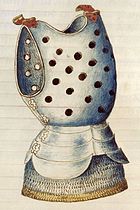- Munition armour
-
 "Three-quarters" cuirassier's armour in Savoyard style (early 17th century).
"Three-quarters" cuirassier's armour in Savoyard style (early 17th century). Typical Swiss or landsknechts half-armour worn by foot soldiers in the 16th century, known in England as almain rivet.
Typical Swiss or landsknechts half-armour worn by foot soldiers in the 16th century, known in England as almain rivet.
Munition armour (also "munitions-grade armour", "munition quality armour") refers to any mass-produced armour, historically stockpiled in armouries to equip both foot soldiers and mounted cuirassiers.
During the Late Middle Ages, plate armour was expensive and tailor-made for the wearer, and consequently mostly reserved for nobility. Early Modern warfare was characterized by the establishment of standing armies equipped with mass-produced ordnance weapons. Munitions-grade armour was produced in both Europe and Japan beginning in the 15th century to equip the standing armies developed from this period.
Munition armour was of a standard pattern with interchangeable pieces. It was often made of iron or sometimes an alloy of iron containing a small amount of phosphorus, which gave a marginal increase in hardness.[1] The phosphorus content may have been due to the use of high-phosphorus ores or the use of coal in smithing. [2]
In Japan, the warfare of the Sengoku period (15th and 16th centuries) required large quantities of armour to be produced for the ever growing armies of foot soldiers (ashigaru). Simple munition quality (okashi or lent)[3]chest armours (dou or dō) and helmets (kabuto) were massed produced including tatami armours which could be folded or collapsible. [4]Tatami armours were made from small rectangular (karuta) or hexagon (kikko) armour plates that were usually connected to each other by chain armour (kusari) and sewn to a cloth backing. Tatami armours could also be made entirely from kusari.[5]
Contents
See also
- Almain rivet
- Plate armour
- Swiss arms and armour
References
- ^ "Royal Armouries: 8. The metallurgy of plate armour". Royal Armouries. Archived from the original on 2007-11-13. http://web.archive.org/web/20071113045322/http://www.royalarmouries.org/extsite/view.jsp?sectionId=3004. Retrieved 2008-02-16.
- ^ Lev, Yaacov (1997). War and Society in the Eastern Mediterranean, 7th–15th Centuries. BRILL. ISBN 9004097775.
- ^ The Watanabe Art Museum Samurai Armour Collection Volume I — Kabuto & Mengu, Trevor Absolon P.130
- ^ Samurai: The Weapons and Spirit of the Japanese Warrior, Clive Sinclaire, Globe Pequot, 2004 P.29
- ^ Samurai 1550-1600, Anthony J. Bryant, Angus McBride, Osprey Publishing, 1994 P.31
Bibliography
- Woosnam-Savage, Robert C.; Anthony Hall (2002). Brassey's Book of Body Armor. Potomac Books, Incorporated. ISBN 1574884654.
External links
Head Armet · Barbute · Bascinet · Burgonet · Cervelliere · Close helm · Close helmet · Great helm · Frog mouth(helm) · Hounskull · Lobster tail pot · Mail coif · Morion · Nasal helmet · Sallet · Spangenhelm · Kettle hat
Visor · Falling buffe · Nossel
Neck Torso Brigandine · Cuirass · Culet · Plackart · Fauld · Hauberk · Codpiece · Lance rest · Loin-guard · Jack of plateArms Legs Component pieces Categories:- Early Modern armour
- Personal armour
- New Model Army
Wikimedia Foundation. 2010.

